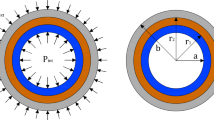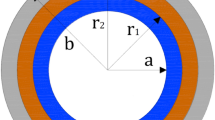Abstract
Decision making on the configuration of material layers as well as thickness of each layer in composite assemblies has long been recognized as an optimization problem. Today, on the one hand, abundance of industrial alloys with different material properties and costs facilitates fabrication of more economical or light weight assemblies. On the other hand, in the design stage, availability of different alternative materials apparently increases the complexity of the design optimization problem and arises the need for efficient optimization techniques. In the present study, the well-known big bang–big crunch optimization algorithm is reformulated for optimum design of internally pressurized tightly fitted multi-layer composite tubes with axially constrained ends. An automated material selection and thickness optimization approach is employed for both weight and cost minimization of one-, two-, and three-layer tubes, and the obtained results are compared. The numerical results indicate the efficiency of the proposed approach in practical optimum design of multi-layer composite tubes under internal pressure and quantify the optimality of different composite assemblies compared to one-layer tubes.







Similar content being viewed by others
References
Akış T, Eraslan AN (2005) Yielding of long concentric tubes under radial pressure based on von Mises criterion. J Fac Eng Archit Gazi Univ 20:365–372 (in Turkish)
Eraslan AN, Akis T (2005) Yielding of two-layer shrink-fitted composite tubes subject to radial pressure. Forsch Ing 69:187–196
Apatay T, Mack W (2015) On the optimum design of rotating two-layered composite tubes subject to internal heating or pressure. Forsch Ing 79:109–122
Miraje AA, Patil SA (2012) Optimum thickness of three-layer shrink fitted compound cylinder for uniform stress distribution. Int J Adv Eng Technol 3(2):591–605
Xia M, Takayanagi H, Kemmochi K (2000) Optimal design of a thick-walled sandwich pipe. Adv Compos Mater 9(4):349–361
Jahed H, Farshi B, Karimi M (2006) Optimum autofrettage and shrink-fit combination in multi-layer cylinders. Trans ASME J Press Vessel Technol 128:196–200
Zhou S-S, Gao X-L, Griffith GW (2012) Stress analysis and structural optimization of a three-layer composite cladding tube under thermo-mechanical loads. J Eng Mater Technol ASME 134(3):031001
Goldberg DE, Samtani MP (1986) Engineering optimization via genetic algorithm. In: Proceeding of the ninth conference on electronic computation, ASCE, pp 471–482
Kirkpatrick S, Gerlatt CD, Vecchi MP (1983) Optimization by simulated annealing. Science 220:671–680
Kennedy J, Eberhart R (1995) Particle swarm optimization. In: IEEE international conference on neural networks, IEEE Press, vol 4, pp 1942–1948
Colorni A, Dorigo M, Maniezzo V (1991) Distributed optimization by ant colony, In: Proceedings of the first European conference on artificial life, USA, pp 134–142
Hasançebi O, Kazemzadeh Azad S (2015) Adaptive dimensional search: a new metaheuristic algorithm for discrete truss sizing optimization. Comput Struct 154:1–16
Erol OK, Eksin I (2006) A new optimization method: big bang–big crunch. Adv Eng Softw 37:106–111
Timoshenko SP, Goodier JN (1970) Theory of elasticity, 3rd edn. Mc-Graw-Hill, New York
Ugural AC, Fenster SK (1987) Advanced strength and applied elasticity, 2 SI edn. Prentice Hall, New Jersey
Boresi AP, Schmidt RJ, Sidebottom OM (1993) Advanced mechanics of materials, 5th edn. Wiley, New York
Atlı A (2010) Analytical investigation of multi-layer composite tubes subject to pressure. MSc Thesis, Atilim University, Ankara, Turkey
Hasançebi O, Kazemzadeh Azad S (2014) Discrete size optimization of steel trusses using a refined big bang–big Crunch Algorithm. Eng Optim 46(1):61–83
Author information
Authors and Affiliations
Corresponding author
Ethics declarations
Conflict of interest
The authors declare that there is no conflict of interests regarding the publication of this paper.
Rights and permissions
About this article
Cite this article
Kazemzadeh Azad, S., Akış, T. Automated selection of optimal material for pressurized multi-layer composite tubes based on an evolutionary approach. Neural Comput & Applic 29, 405–416 (2018). https://doi.org/10.1007/s00521-016-2563-6
Received:
Accepted:
Published:
Issue Date:
DOI: https://doi.org/10.1007/s00521-016-2563-6




